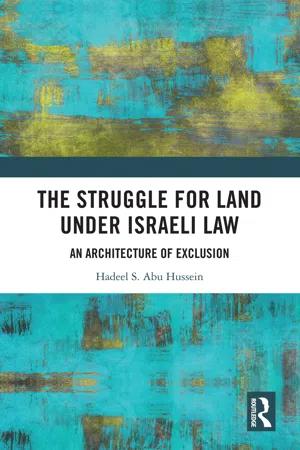
The Struggle for Land Under Israeli Law
An Architecture of Exclusion
- 256 pages
- English
- ePUB (mobile friendly)
- Available on iOS & Android
About this book
This book provides a comprehensive examination of land law for Arab Palestinians under Israeli law.
Land is one of the core resources of human existence, development and activity. Therefore, it is also a key basis of political power and of social and economic status. Land regimes and planning regulations play a dynamic role in deciding how competing claims over resources will be resolved. According to legal geography, spatial ordering impacts legal regimes; whilst legal rules form social and human space. Through the lenses of international law, colonisation and legal geography, the book examines the land regime in Israel. More specifically, it endeavours to understand the spatial strategies adopted by Israel to organise the entire territorial expanse of the country as Jewish, while also excluding Arab Palestinian citizens of Israel and residents of East Jerusalem from the landscape. The book then details how the systematic nature and processes of marginalisation are mapped out across the civil, political and socio-economic landscape.
This monograph will be of interest to international legal theorists, legal geographers, land lawyers and human rights practitioners and students; as well as to international scholars, NGOs and others focusing on the Israeli–Palestinian conflict.
Frequently asked questions
- Essential is ideal for learners and professionals who enjoy exploring a wide range of subjects. Access the Essential Library with 800,000+ trusted titles and best-sellers across business, personal growth, and the humanities. Includes unlimited reading time and Standard Read Aloud voice.
- Complete: Perfect for advanced learners and researchers needing full, unrestricted access. Unlock 1.4M+ books across hundreds of subjects, including academic and specialized titles. The Complete Plan also includes advanced features like Premium Read Aloud and Research Assistant.
Please note we cannot support devices running on iOS 13 and Android 7 or earlier. Learn more about using the app.
Information
Chapter 1
Introduction – access denied
1.1 On theory, colonialism, law, and the ethnocratic State
While they (the colonial powers) may have displaced, distorted, and (most often) denied, the capacities that inhere within the colonial past are routinely reaffirmed and reactivated in the colonial present, despite the critics in colonialism, the postcolonialism is usually distinguished from these projects by its central interest in relations between culture and power.55 Derek Gregory, The Colonial Present: Afghanistan, Palestine, Iraq, Malden, MA: Blackwell, 2004.
In modern societies, the relationship between legality and legitimacy is […] one of virtual identity. Law not only provides the technical apparatus for exercise of state power but also the ideological foundation of authority.77 Cited in Roger Cotterrell, ‘Legality and Political Legitimacy in the Sociology of Max Weber’ in David Sugarman (ed) Legality, Ideology and the State, Cambridge, MA: Academic Press, 1983.
Property is a system of social relation between people.The failure to protect a set of interests as exclusive property rights leaves the people who assert those interests vulnerable to others. Both the creation and the failure to create property rights leaves people open to harm, either at the hands of state or at the hands of other persons. A central question, therefore, is how the legal system goes about defining and allocating property rights.99 Joseph William Singer, ‘Sovereignty and Property’, Nw. UL Rev. 86 (1991): 1.
the importance of legalities, broadly defined, in the imposition of control by Europe over its various ‘others’: how law was ‘the cutting edge of colonialism, an instrument of the power of an alien state and part of the process of coercion’ […] how it became a ‘tool for pacifying and governing […] colonized peoples’.1414 John L Comaroff, ‘Symposium Introduction: Colonialism, Culture, and the Law: A Foreword’, 26 Law & Soc. Inquiry 305 (2001): 306.
Too little attention has also been given to the basic fact that the British, aided by their colonial experience elsewhere, created and installed a functioning state in Palestine: a rather advanced web of administrative apparatuses and governmental departments, a sound infrastructure and, of course, a fully-developed, ready-to-use legal system.2020 Ronen Shamir, The Colonies of Law: Colonialism, Zionism and Law in Early Mandate Palestine, Cambridge: Cambridge University Press, 2000: 11.
Table of contents
- Cover
- Half-Title
- Title
- Copyright
- Dedication
- Contents
- Abstract
- Acknowledgements
- 1 Introduction – access denied
- 2 A review of land rights in international law context
- 3 An architecture of exclusion
- 4 Towards building the present land regime in Israel: Legislation and judicial systems
- 5 Case study, Sheikh Jarrah as a contemporary struggle
- 6 Conclusion: Exploring the dark side of land law
- Bibliography
- Table of Israeli court cases
- Index